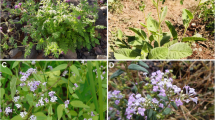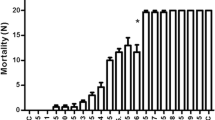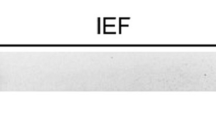Abstract
Aedes aegypti transmits the viruses that cause yellow and dengue fevers. Vector control is essential, since a vaccine for dengue has not as yet been made available. This work reports on the larvicidal activity of Myracrodruon urundeuva leaf lectin (MuLL) against A. aegypti fourth-stage larvae (L4). Also, the resistance of MuLL to digestion by L4 gut proteases and the effects of MuLL on protease, trypsin-like and α-amylase activities from L4 gut were evaluated to determine if lectin remains active in A. aegypti gut and if insect enzyme activities can be modulated by MuLL. MuLL promoted mortality of L4 with LC50 of 0.202 mg/ml. Haemagglutinating activity of MuLL was detected even after incubation for 96 h with L4 gut preparation containing protease activity. MuLL affected the activity of gut enzymes, inhibiting protease and trypsin activities and stimulating α-amylase activity. The results suggest that MuLL may become a new biodegradable larvicidal agent for dengue control. Larvicidal activity of MuLL may be linked to its resistance to proteolysis by larval enzymes and interference in the activity of digestive larval enzymes.


Similar content being viewed by others
References
Aiub CAF, Coelho ECA, Sodré E, Pinto LFR, Felzenszwalb I (2002) Genotoxic evaluation of the organophosphorous pesticide temephos. Genet Mol Res 1:159–166
Applebaum SW, Jankovic M, Birk Y (1961) Studies on the midgut amylase activity of Tenebrio molitor L. larvae. J Insect Physiol 7:100–108
Araújo AP, Melo-Santos MAV, Carlos SO, Rios EMMM, Regis L (2007) Evaluation of an experimental product based on Bacillus thuringiensis sorovar. israelensis against Aedes aegypti larvae (Diptera:Culicidae). Biol Control 41:339–347
Autran ES, Neves IA, da Silva CSB, Santos GKN, da Câmara CAG, Navarro DMAF (2009) Chemical composition, oviposition deterrent and larvicidal activities against Aedes aegypti of essential oils from Piper marginatum Jacq. (Piperaceae). Bioresour Technol 100:2284–2288
Azeez A, Sane AP, Bhatnagar D, Nath P (2007) Enhanced expression of serine proteases during floral senescence in Gladiolus. Phytochemistry 68:1352–1357
Babu SR, Subrahmanyam B (2010) Bio-potency of serine proteinase inhibitors from Acacia senegal seeds on digestive proteinases, larval growth and development of Helicoverpa armigera (Hübner). Pest Biochem Physiol 98:349–358
Bagavan A, Rahuman AA, Kamaraj C, Geetha K (2008) Larvicidal activity of saponin from Achyranthes aspera against Aedes aegypti and Culex quinquefasciatus (Diptera: Culicidae). Parasitol Res 103:223–229
Bernfeld P (1955) Amylases, α and β. Methods Enzymol 1:149–158
Bhattacharyya A, Leighton SM, Babu CR (2007) Bioinsecticidal activity of Archidendron ellipticum trypsin inhibitor on growth and serine digestive enzymes during larval development of Spodoptera litura. Comp Biochem Physiol C 145:669–677
Bing DH, Weyand JG, Stavinsky AB (1967) Hemagglutination with aldehyde-fixed erythrocytes for assay of antigens and antibodies. Proc Soc Exp Biol Med 124:1166–1170
Borovsk D, Meola SM (2004) Biochemical and cytoimmunological evidence for the control of Aedes aegypti larval trypsin with Aea-TMOF. Arch Insect Biochem Phys 55:24–139
Carlini CR, Grossi-de-Sá MF (2002) Plant toxic proteins with insecticidal properties. A review on their potential as bioinsecticides. Toxicon 40:1515–1539
Coelho MB, Marangoni S, Macedo MLR (2007) Insecticidal action of Annona coriacea lectin against the flour moth Anagasta kuehniella and the rice moth Corcyra cephalonica (Lepidoptera: Pyralidae). Comp Biochem Physiol C 146:406–414
Coelho JS, Santos NDL, Napoleão TH, Gomes FS, Ferreira RS, Zingali RB, Coelho LCBB, Leite SP, Navarro DMAF, Paiva PMG (2009) Effect of Moringa oleifera lectin on development and mortality of Aedes aegypti. Chemosphere 77:934–938
Correia MTS, Coelho LCBB, Paiva PMG (2008) Lectins, carbohydrate recognition molecules: are they toxic? In: Siddique YH (ed) Recent trends in toxicology, vol. 37. Transworld Research Network, Kerala, pp 47–59
Czapla TH, Lang BA (1990) Effect of plant lectins on the larval development of European corn borer (Lepidoptera: Pyralidae) and southern corn rootworm (Coleoptera: Chrysomelidae). J Econ Entomol 83:2480–2485
Dubois M, Gilles KA, Hamilton JK, Rebers PA, Smith F (1956) Colorimetric method for determination of sugar and related substances. Anal Chem 28:350–356
Eisemann CH, Donaldson RA, Pearson RD, Cadogan LC, Vacuolo T, Tellman RL (1994) Larvicidal activity of lectins on Lucilia cuprina: mechanism of action. Entomol Exp Appl 72:1–11
Fitches E, Philip J, Hinchliffe G, Vercruysse L, Chougule N, Gatehouse JA (2008) An evaluation of garlic lectin as an alternative carrier domain for insecticidal fusion proteins. Insect Sci 15:483–495
García-Carreño FL, Dimes LE, Haard NF (1993) Substrate gel electrophoresis for composition and molecular weight of proteinases and proteinaceous proteinase inhibitors. Anal Biochem 214:65–69
Kakade ML, Simons N, Liener IE (1969) An evaluation of natural vs. synthetic substrates for measuring the antitryptic activity of soybean samples. Cereal Chem 46:518–526
Laemmli UK (1970) Cleavage of structural proteins during the assembly of the head of bacteriophage T4. Nature 227:680–685
Lagarda-Diaz I, Guzman-Partida AM, Urbano-Hernandez G, Ortega-Nieblas MM, Robles-Burgeño MR, Winzerling J, Vazquez-Moreno L (2009) Insecticidal action of PF2 lectin from Olneya tesota (Palo Fierro) against Zabrotes subfasciatus larvae and midgut glycoconjugate binding. J Agric Food Chem 57:689–694
Lam SK, Ng TB (2011) Lectins: production and practical applications. Appl Microbiol Biotechnol 89:45–55
Lowry OH, Rosebrough NJ, Farr AL, Randall RJ (1951) Protein measurement with the Folin phenol reagent. J Biol Chem 193:265–275
Macedo MLR, Damico DCS, Freire MGM, Toyama MH, Marangoni S, Novello JC (2003) Purification and characterization of an N-acetylglucosamine-binding lectin from Koelreuteria paniculata seeds and its effect on the larval development of Callosobruchus maculatus (Coleoptera: Bruchidae) and Anagasta kuehniella (Lepidoptera: Pyralidae). J Agric Food Chem 51:2980–2986
Macedo MLR, Castro MM, Freire MGM (2004) Mechanisms of the insecticidal action of TEL (Talisia esculenta lectin) against Callosobruchus maculatus (Coleoptera: Bruchidae). Arch Insect Biochem Physiol 56:84–96
Macedo MLR, Freire MGM, Silva MBR, Coelho LCBB (2007) Insecticidal action of Bauhinia monandra leaf lectin (BmoLL) against Anagasta kuehniella (Lepidoptera: Pyralidae), Zabrotes subfasciatus and Callosobruchus maculatus (Coleoptera: Bruchidae). Comp Biochem Physiol A 146:486–498
McGeachin RL, Willis TG, Roulston EF, Lang CA (1972) Variation in alpha-amylase during the life span of the mosquito. Comp Biochem Physiol B 43:185–191
Melo-Santos MAV, Varjal-Melo JJM, Araújo AP, Gomes TCS, Paiva MHS, Regis LN, Furtado AF, Magalhães T, Macoris MLG, Andrighetti MTM, Ayres CFJ (2010) Resistance to the organophosphate temephos: mechanisms, evolution and reversion in an Aedes aegypti laboratory strain from Brazil. Acta Trop 113:180–189
Monath TP (2008) Treatment of yellow fever. Antiviral Res 78:116–124
Nanasahe PC, Doyle E, Fitches E, Gatehouse JA (2008) Biochemical characterization of midgut digestive proteases from Mamestra brassicae (cabbage moth; Lepidoptera: Noctuidae) and effect of soybean Kunitz inhibitor (SKTI) in feeding assays. J Insect Physiol 54:563–572
Napoleão TH, Gomes FS, Lima TA, Santos NDL, Sá RA, Albuquerque AC, Coelho LCBB, Paiva PMG (2011) Termiticidal activity of lectins from Myracrodruon urundeuva against Nasutitermes corniger and its mechanisms. Int Biodeter Biodegr 65:52–59
Navarro DMAF, Oliveira PES, Potting RJP, Brito AC, Fital SJF, Sant’Ana AEG (2003) The potential attractant or repellent effects of different water types on oviposition in Aedes aegypti L. (Dipt., Culicidae). J Appl Entomol 127:46–50
Oliveira CFR, Luz LA, Paiva PMG, Coelho LCBB, Marangoni S, Macedo MLR (2011) Evaluation of seed coagulant Moringa oleifera lectin (cMoL) as a bioinsecticidal tool with potential for the control of insects. Process Biochem 46:498–504
Poupardin R, Reynaud S, Strode C, Ranson H, Vontas J, David JP (2008) Cross-induction of detoxification genes by environmental xenobiotics and insecticides in the mosquito Aedes aegypti: impact on larval tolerance to chemical insecticides. Insect Biochem Mol Biol 38:540–551
Rajkumar S, Jebanesan A (2008) Bioactivity of flavonoid compounds from Poncirus trifoliate L. (Family: Rutaceae) against the dengue vector, Aedes aegypti L. (Diptera: Culicidae). Parasitol Res 104:19–25
Sá RA, Napoleão TH, Santos NDL, Gomes FS, Albuquerque AC, Xavier HS, Coelho LCBB, Bieber LW, Paiva PMG (2008) Induction of mortality on Nasutitermes corniger (Isoptera, Termitidae) by Myracrodruon urundeuva heartwood lectin. Int Biodeter Biodegr 62:460–464
Sá RA, Argolo ACC, Napoleão TH, Gomes FS, Santos NDL, Melo CML, Albuquerque AC, Xavier HS, Coelho LCBB, Bieber LW, Paiva PMG (2009a) Antioxidant, Fusarium growth inhibition and Nasutitermes corniger repellent activities of secondary metabolites from Myracrodruon urundeuva heartwood. Int Biodeter Biodegr 63:470–477
Sá RA, Santos NDL, da Silva CSB, Napoleão TH, Gomes FS, Cavada BS, Coelho LCBB, Navarro DMAF, Bieber LW, Paiva PMG (2009b) Larvicidal activity of Myracrodruon urundeuva lectins on Aedes aegypti. Comp Biochem Physiol C 149:300–306
Segel IH (1975) Enzyme kinetics: Behavior and analysis of rapid equilibrium and steady state enzyme systems. Wiley-Interscience, New York, 984
Souza SMC, Aquino LCM, Milach AC Jr, Bandeira MAM, Nobre MEP, Viana GSB (2006) Antiinflammatory and antiulcer properties of tannins from Myracrodruon urundeuva Allemão (Anacardiaceae) in rodents. Phytother Res 21:220–225
Tauil PL (2002) Aspectos clínicos do controle do dengue no Brasil. Cad Saude Publica 18:867–871
Tellam RL, Wijffels G, Wiladsen P (1999) Peritrophic matrix proteins. Insect Biochem Mol Biol 29:87–101
Viana GSB, Bandeira MAM, Matos FJA (2003) Analgesic and antiinflammatory effects of chalcones isolated from Myracrodruon urundeuva Allemão. Phytomedicine 10:189–195
World Health Organization (1981) Instructions for determining the susceptibility or resistance of mosquito larvae to insecticides. WHO/VBC/81.807, pp. 1–6
World Health Organization (2009a) Yellow Fever. Fact sheet 100
World Health Organization (2009b) Dengue and dengue haemorrhagic fever. Fact sheet 117
Yang YJ, Davies DM (1971) Trypsin and chymotrypsin during metamorphosis in Aedes aegypti and properties of the chymotrypsin. J Insect Physiol 17:117–131
Zhu-Salzman K, Shade RE, Koiwa H, Salzman RA, Narasimhan M, Bressan RA, Hasegawa PM, Murdock LL (1998) Carbohydrate binding and resistance to proteolysis control insecticidal activity of Griffonia simplicifolia lectin II. Proc Natl Acad Sci USA 95:15123–15128
Acknowledgments
This study was supported by research grants and fellowships (LCBBC, PMGP) from the Conselho Nacional de Desenvolvimento Científico e Tecnológico (CNPq) and financial support from the Fundação de Amparo à Ciência e Tecnologia do Estado de Pernambuco (FACEPE) and the Coordenação de Aperfeiçoamento de Pessoal de Nível Superior (CAPES). We thank Maria Barbosa Reis da Silva for technical assistance and Felix Nonnenmacher for English editing.
Author information
Authors and Affiliations
Corresponding author
Rights and permissions
About this article
Cite this article
Napoleão, T.H., Pontual, E.V., de Albuquerque Lima, T. et al. Effect of Myracrodruon urundeuva leaf lectin on survival and digestive enzymes of Aedes aegypti larvae. Parasitol Res 110, 609–616 (2012). https://doi.org/10.1007/s00436-011-2529-7
Received:
Accepted:
Published:
Issue Date:
DOI: https://doi.org/10.1007/s00436-011-2529-7




